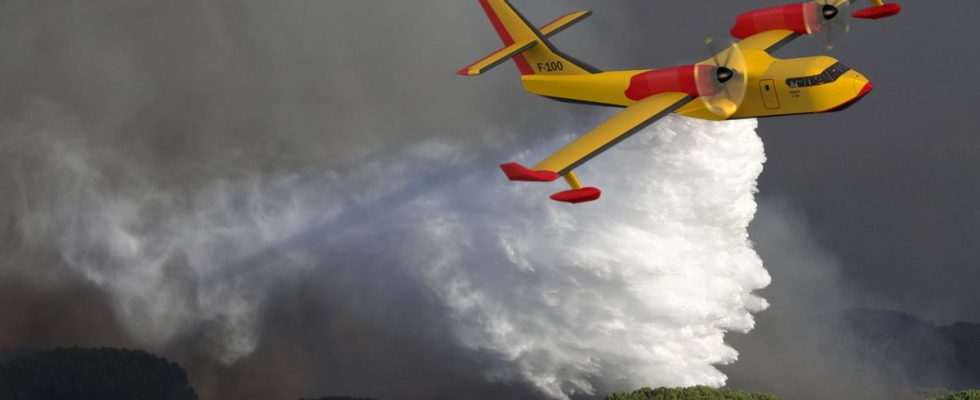Will Canadair’s competitor see the light of day on the tarmac of Bordeaux-Mérignac airport? The airport and Hynaero announced Thursday the signing of a partnership for the establishment of the start-up’s offices and the assembly plant for the future Fregate-F100.
Established today within the Bordeaux Technowest start-up incubator, the young start-up supported by the Nouvelle-Aquitaine region and the Bordeaux Metropolis, will soon join Cockpit, the innovation hub dedicated to aeronautics located in Mérignac, a stone’s throw from Dassault and Thalès. Hynaero wishes to design there, then assemble in a runway-side factory, the Fregate-F100, an amphibious water bomber aircraft, which aims, if not to succeed, at least to compete with the Canadair which currently equips the Civil security in France and Europe. “Between these two stages, the large sub-assemblies will be manufactured by companies in the aeronautical sector which have the skills for this” explains to 20 minutes one of the managers of the start-up, David Pincet.
“Sovereignty issue”
Formerly of the Air Force and civil security in Nîmes, David Pincet and his partners launched this project because “the demand for aerial capacity to fight forest fires will explode in the coming years”, assures -it, and because it is an “environmental necessity.” » “Until three years ago, forest fires were a consequence of global warming, now the multiplication of very large fires is becoming a cause of climate change. »
Finally, “there is an issue of sovereignty behind this subject” maintains the entrepreneur. “Since 1970, the Canadair, an aircraft manufactured in Canada, has been the benchmark. We must regain control of this capacity,” believes David Pincet. In Europe, the fleet is currently made up of 90 Canadairs, based in France (12 aircraft), Greece, Croatia, Italy and Spain. If each country is responsible for its fleet, a European mutual aid mechanism has been set up so that these nations mobilize their planes where they are needed during major fires.
“A need for 300 aircraft between 2030 and 2050”
These devices are on average 30 years old, “they will therefore need to be renewed between 2030 and 2050” anticipates David Pincet. “At 70 million euros each, just for the replacement of the 90 Canadairs flying in Europe, this already represents around 6 billion euros of investment. However, we estimate that the need for fleet renewal and growth between 2030 and 2050 will be 300 aircraft. » Hynaero, which would already be in balance with the sale of 50 aircraft, is targeting “half of this market. »
But what will the start-up propose to tickle Canadair, which has proven itself over decades? “Already, you should know that it has been eight years since the Canadair was no longer built,” explains David Pincet. If Canada succeeds in relaunching production for 2030, it will only reproduce an aircraft designed at the end of the 1960s, when our project integrated several innovations. For the same price, we will carry more than ten tonnes of water compared to six for the Canadair, and we will fly at 250 knots compared to 180 knots for our competitor. In addition to this, we will embed a mission system that we are currently defining with the firefighters and pilots. And ultimately, we make the French and European economy work. » This industrial project would ultimately represent more than 450 direct jobs on site, and 2,000 jobs in the ecosystem with subcontracting.
The start-up is currently in the process of raising funds to complete the entire initial design of the aircraft between the summer of 2024 and 2025. “At the same time, we are preparing the design of the factory, to be ready to launch our prototype in 2028, obtain our certification flights in 2029-2030, and enter service in 2031.”

